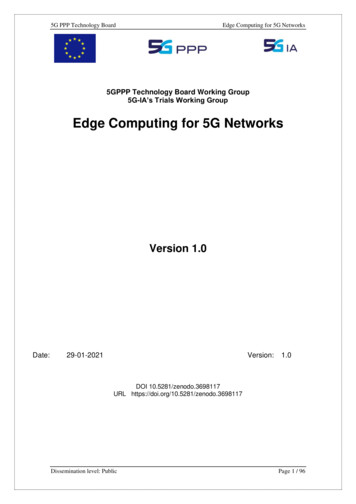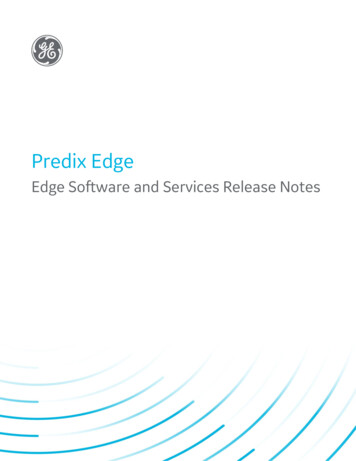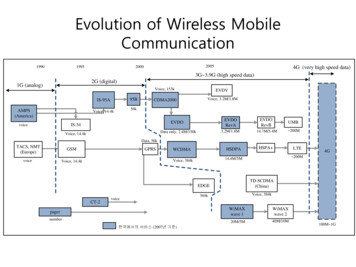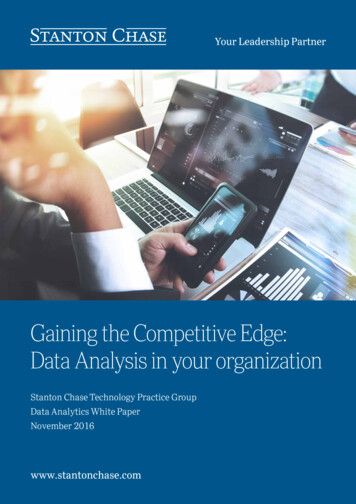
Transcription
Your Leadership PartnerGaining the Competitive Edge:Data Analysis in your organizationStanton Chase Technology Practice GroupData Analytics White PaperNovember 2016www.stantonchase.com
Your Leadership PartnerI.II.III.IntroductionExecutive SummaryFindingsA. Common LanguageB. Data AgilityC. Collaborative Data AnalysisIV.V.VI.RecommendationsConclusionAbout Stanton ChaseVII. About the AuthorVIII. Sources
I. IntroductionThe Stanton Chase Technology Practice Group is a strategicpartner to clients within all major market sectors and regions.Recently, in ongoing conversations with our clients, we have heardmany executives voice concerns relating to the seemingly endlessopportunities and overwhelming demands presented by big data.Kevin BradburyPartner 31 61 149 8686k.bradbury@stantonchase.com How can we identify and acquire the best talent that will approachdata analysis with ingenuity? Who will pioneer and evangelize the adoption of data analysis effortsin our organization? How can we, as an executive management team, harness the potentialof our data and utilize it to gain a better comprehension of businessprocesses, meet current objectives, and plan for future successes? How can we clearly understand and communicate our organization’sproprietary data?By 2020, the number of internet-connected devices recordingor generating information is expected to increase by 400% andthe amount of data stored will grow 50-fold, transforming everybusiness into a data-driven business.In short, accumulating massive amounts of data is – or soon will be –commonplace for every major organization. Simply owning data willnot be enough to differentiate your organization from its rivals.To give your business a competitive edge, you must acquire creative,data analytically minded talent within every function and at every levelof your organization.In addition to utilizing our own expertise, we reached out to industryleaders and compiled the latest research regarding how the C-suitecurrently uses and would like to use data analytics to meet theirbusiness objectives, and how acquiring talent focused on dataanalytics beyond IT can give an organization a fresh perspective.We hope you find this information insightful and valuable.We look forward to discussing it further with you. Should youhave any questions regarding this white paper, please visitwww.stantonchase.com or contact your local Stanton Chase office.3
II. Executive SummaryIn a time when many companies’ reach spans countries and continents, clear lines of communicationhave become increasingly difficult. Rapidity and agility are defining characteristics of doing businessin 2016, and it is crucial that executives across geographic locations and functions have an up-todate understanding of where their team and the company stand in relation to business objectives.Common LanguageData analytics has become the common language for clearly communicating across departmentsand locations, as quantifiable data leaves no room for misunderstanding. However, as static reportsquickly become outdated and do not allow the flexibility that today’s economy demands, the datadashboard is the most direct and powerful tool for CxOs to keep track of their key performanceindicators (KPIs). To track metrics and KPIs, each executive needs a concise and customizabledashboard that offers a graphical, easy-to-read summary of relevant data within the appropriatehistorical, functional, and geographical context.Data AgilityWhen it comes to data, quantity is not the problem; quality is. The majority of companies feelthey have access to sufficient amounts of data. Unfortunately, they do not have the right resourcesto make sense of it. Many executives feel they are often presented with an influx of data sooverwhelming it renders decision-making nearly impossible.Data agility transforms an operational asset into a strategic one. The same set of data can be minedand reinterpreted multiple ways to be relevant to different functions within the same organization.Executives must approach this malleable mass of data and understand how to extract value thattriggers actions.Collaborative Data AnalysisCompanies recognize big data as a top priority spend, but they struggle to find talent that canapproach data analysis with creativity and innovation. However, despite this talent shortage,companies are hesitant to outsource their data analysis to third parties, instead preferring to keeptheir data analysis in-house.“ The solution? Identify, attract, and retain data-minded talentacross functions, rather than limiting it solely to IT. Dataanalysis must be adopted as a collaborative, company-widemindset in order to create the right environment in whichdata-minded talent can strive, prosper, and innovate.”4
III. FindingsCommon LanguageData analytics has become the common language for clearly communicating across departmentsand locations.Communicating via quantifiable data leaves no room for misunderstanding. Numbers, charts,and graphs ensure that executives across functions and geographic locations have a clearunderstanding of where they stand in relation to their business objectives.“Data really powers everything that we do.” – Jeff Weiner, CEO LinkedInKey performance indicators, or KPIs, are specifically selected metrics or blends of multiple metricsused to track business objectives. KPIs should be attributable to the actions of a specific group,and in order to be effective, they must have clear ownership and measure accountability.Static reports quickly become outdated and do not provide the agility that today’s marketsdemand. The data dashboard is the most direct and powerful tool for CxOs to keep trackof their KPIs. In a recent study conducted by Domo of over 1,000 business leaders acrossseveral industries, 72% of respondents wished they could view their business data in dynamic,visually appealing dashboards. At Salesforce, Chet Chauhan, VP Product Managementfor CRM Applications noted “The type of device displaying the dashboard is no longeras relevant. This is due to a seamless continuum with modern cloud software that worksacross all platforms such as mobile, tablet, desktop, even screen projection from mobiles.”A vast majority of CxOs feel having greater access to crucial data is vital to their success. Accordingto a 2015 study conducted by the Economist Intelligence Unit of 395 C-level executives, 67% saidtheir department’s business functions would be substantially enhanced by improved access tobig data. This sentiment was echoed this year in a NewVantage Partners survey of Fortune 1,000executives in which 70% of respondents considered big data as very important or mission criticalto their business success.To track key metrics and KPIs, each executive needs a concise and customizable dashboard thatoffers a graphical, easy-to-read summary of relevant data within the appropriate historical,functional, and geographical context. If a set of data is not directly connected to a CxO’s proprietaryKPIs, then it should be considered unneeded for the time being.An effective dashboard should clearly show the directionality of every KPI within a predetermined,relevant timeframe. How does this figure compare to last week? Last month? Last quarter? Last year?For a company with multiple locations, geographic comparisons are also important to show regionalvariations. How does this data compare to other locations with similar economic or demographicfactors? To other domestic locations? To international ones? This contextualization adds a narrativeto what would otherwise be purely quantitative facts that paint a one-dimensional picture.5
Data AgilityThe majority of company leaders feel they have access to sufficient quantities of data; unfortunately,they do not have the right resources to make sense of it.The Internet of Things currently allows companies to gather an unprecedented volume of data.In fact, by 2020, the total amount of data stored is expected to be 50 times larger than it was in 2015.The majority of companies feel they have access to sufficientquantities of data; unfortunately, they do not have the rightresources to make sense of it.“Data is the new science. Big Data holds the answers.” – Pat Gelsinger, CEO VMwareThe pendulum has swung from one extreme to another. In the past, executives were frequently facedwith a data deficit that left them ill-equipped to make well informed decisions; today they are oftenpresented with an influx of data so overwhelming that it renders decision-making nearly impossible.The challenge is to find a balance where executives have access to accurate, relevant data.“At its core, data is an operational asset. But through analysis, it can become a strategic one,”explains Jan-Bart Smits, Global Technology Practice Leader at Stanton Chase. “The same setof data can be mined and reinterpreted multiple ways to be relevant to different functions withinthe same organization.” Executives must approach this malleable mass of data and understandhow to extract value that results in actionable steps towards improved performance. Contextualizingthe information can greatly increase its relevance: historically, geographically, functionally,and within the context of external economic and social factors.6
The NewVantage Partners study reveals that when it comes to data, it is not a problem of costor quantity, but of agility and variety. Only 9% of respondents are focused on reducing data storageand analysis costs and only 13% are focused on integrating greater amounts of data. However, 31%are concerned with greater data agility and 40% with greater data variety.In the same Domo survey mentioned above, an overwhelming 93% of respondents indicated theyrely on business information to do their jobs well, but only 43% report they have access to theinformation they need, and 68% regularly have difficulty making sense of the information thatthey do have access to.Organizations are less concerned withincreasing the amount of data they haveor reducing the cost required to obtain it,but rather with how to effectively interpret it.Additionally, a 2015 survey of over 1,100 managers and executives conducted by IDG Enterprisereiterates this trend. 56% of respondents say they frequently feel overwhelmed by incoming dataand information, and 53% say the influx of large quantities of data has delayed important decisions.All of these surveys come to the same conclusion: Organizations are less concerned with increasingthe amount of data they have or reducing the cost required to attain it, but rather with how toeffectively interpret it.7
Collaborative Data AnalysisCompanies are willing to invest resources in data analysis but want to keep it ‘close to home’with in-house teams.“Companies recognize that investing in the resources needed to capture and analyze big data is a toppriority,” says Mickey Matthews, International Chairman of Stanton Chase. “But there is a veritabledisconnect between a willingness to invest in data analysis and acquiring the human capital to doso.” In fact, a recent survey by Forbes Insights of 316 executives of large global companies found thata staggering 90% report medium to high levels of investment in big data analytics. But regardlessof their willingness to spend, 46% of the executives surveyed reported that acquiring talent thatcan recognize opportunities for optimization and innovations in data is a challenge.“With too little data, you won’t be able to make any conclusions that you trust. With loads of datayou will find relationships that aren’t real Big data isn’t about bits, it’s about talent.” – DouglasMerrill, CEO Zestfinance.comSimilarly, the 2015 IDG survey found that the primary challenge facing respondents (48%)is the shortage of employees with data analysis and data management skills. The 2015 MIT SloanManagement Review had similar findings, with 40% of companies surveyed struggling to findand keep data analytics talent. According to research done by Tech Crunch in December 2015,some industry experts expect matters to intensify in coming years, with the global demandfor data scientists projected to exceed supply by more than 50% by 2018.According to research done by Tech Crunch in December2015, some industry experts expect matters to intensifyin coming years, with the global demand for data scientistsprojected to exceed supply by more than 50% by 2018.8
However, despite this talent shortage, companies are hesitant to outsource their data analysisto third parties. The Economist Intelligence Unit’s study found that using technical advisors wasthe least popular strategy amongst the executives surveyed for getting value from big data tools,with only 19% of respondents endorsing such programs.The solution? Attract and retain data-minded executives across all top-level functions, rather thansolely within IT.“ Data analysis must be adopted as a collaborative,company-wide mindset.”IDG found that when it comes to making strategic decisions around data-driven initiatives, CIOsor top IT executives have responsibility for these projects only 30% of the time, with CEOs, CFOs,and CMOs also playing key roles. The Economist Intelligence Unit’s study supported this finding,as well, with 56% of CEOs confirming that big data requires collaboration among C-suite executives.“A single executive or even a single team within a company will never be able to identify all of thepotential opportunities for data analysis to effect change within an organization,” Smits confirms.“Data analysis must be adopted as a collaborative, company-wide mindset.”9
IV. RecommendationsIn many ways, business decisions are harder today than in the past. The different types andcombinations of data offer a nearly infinite choice of what to analyze. “Selecting the right factorscan solidify your organization’s place in the market with a clear competitive edge,” states Matthews.“But selecting the wrong ones can have you fall behind competitors or, worse yet, institute strategiesthat are destructive to your business.”As the types of data available become more varied and tangential to your core business, executivesneed the right balance of logic and creativity to understand how employees within every functionof an organization can utilize data analysis to spur strategic changes.Based on our extensive experience with organizations across all sectors and markets worldwide,we offer the following recommendations for acquiring, nurturing, and further encouraging dataanalytically minded talent across every function of your organization:Prioritize Data AccessibilityAfter an organization’s talent, data is its most valuable asset. Make sure it is accessible to keydecision makers. Dashboards must be clean, clear, and easy to read. In order to be relevant, datamust be current and readily available from anywhere at any time via any device, not just from theoffice computers at predetermined intervals.Be Selective About KPIsWith the overwhelming amount of data available today, it is essential to remember that all metricsare not equally important. Your company may have access to hundreds or thousands of metrics, butno single executive has the time or the need to review them all. When deciding which informationto extract and analyze, follow the guideline that every KPI should link directly to a specific businessobjective, should be attributable to the actions of a specific group, have clear ownership, andmeasure accountability. A tiered KPI structure with drill-down analytics is particularly important.Encourage Creativity in Operations, Not Just EfficiencyHistorically, Operations has been largely responsible for monitoring processes for accuracy, speed,and efficiency. These duties are still at the core of Operations’ role; however, the phenomenalincrease in available data can empower Operations to be an innovative force for every functionof the organization. Today’s COOs need to approach data analytics with creativity, not only to rootout inefficiencies, but to devise ways for their organization to revolutionize their processes, both inconcept and execution. This can enable the role of Operations to transform from a reactive one thatsolves problems post mortem to a proactive one that originates and initiates improved processes.10
Acquire HR Talent That Understands ContextualizationPerhaps more than any other function, Human Resources faces the challenge of translatingquantitative measures into qualitative feedback by blending a multitude of metrics and examiningthose metrics on several different levels. Contextualizing KPIs is especially relevant with HumanResources, since identifying, obtaining, and retaining the right mix of top talent requires anintegration of both objective and subjective factors. Candidates must have the required skills,but personal and cultural elements can vary widely from team to team and location to location.Examining KPIs on historical, geographical, and functional levels will enable an organization’sHuman Resources team to hone in on the challenges unique to each subset and adjust theirexpectations and processes accordingly.Look to Sales and Marketing to Construct a NarrativeSales and Marketing is faced with a dilemma based on the magnitude and variation of data relevantto their business objectives. Although many sales and marketing KPIs are actionable, or able tobe directly controlled by an organization, more so than any other function, Sales and Marketingstrategies can be affected by external factors, such as the state of the economy, trends within theindustry, changes within the population of a targeted market, or even significant weather. Manyof these are difficult to predict and impossible to control, but can directly affect Sales and Marketingefforts in significant ways.The CMO needs to be cognizant of which external factors and drivers are pertinent to their objectivesand incorporate these into their proprietary metrics, blending these together to create a narrativeof the customer experience. Sales exceeded expectations in one region but fell short in another –what external factors may have contributed to this? A new competitor targeting the same area?An increase or decrease in the population of a particular customer demographic? A marketingcampaign was less effective than anticipated – what outside factors might have impacted to thisissue? A misconception within the industry? A supporting technology did not perform as anticipated?How can these factors be recreated or avoided in the future? Sales and Marketing needs to maximizethe capabilities of big data to analyze and interpret not just their organization’s own metrics,but external ones, as well.11
Utilize Finance as a Predictive ForceThe biggest challenge facing today’s CFO is selecting the appropriate metrics to monitor whenpresented with the sheer volume of data available. With so many measureable factors contributingto financial business objectives, Finance faces a significant challenge in successfully identifyingwhich metrics are relevant to strategic objectives and which can be considered ancillary.It is critical for Finance executives to possess the skillset that enables them to identify the ‘biggerpicture’ metrics and review historical highs, lows, and patterns to create predictive measures –an invaluable tool when developing and forecasting future KPIs.Build an Innovative IT DepartmentAlthough research shows that adopting a data analytical mindset throughout the organizationis important, the foundation of big data will for the time being remain within the realm of IT.The Chief Information Officer holds a unique and important role that requires they builda team with a particular blend of operational knowledge and strategic understanding.The operational component may be seem a bit more straightforward: the IT department must havean extensive understanding of the organization’s proprietary data and secure that data’s integrity.Beyond that, they must implement the interconnectivity of internal and external data sourcesacross all departments and third-party service providers.The strategic component requires a bit more creativity, as well as collaboration between theCIO and other CxOs. Your organization needs a Chief Information Officer that demonstratesan understanding of the inner workings of each of the organization’s functions. The CIO mustwork closely with his or her peers in other departments to explain the different types of dataavailable, determine the data factors that are relevant to their business objectives, source thatdata, and present that data in such a way that it can easily be incorporated into company KPIs.12
V. ConclusionData touches every aspect of an organization. It allows a deeper understanding of how a companyconducts itself and is a powerful tool in developing, meeting, and exceeding relevant KPIs.Each CxO has unique opportunities and challenges when looking to apply data analytics to theirbusiness objectives in a meaningful way. Every executive, regardless of their function, mustunderstand and expect a higher level of data analysis from themselves and from their team.At every organization in every industry in every location, big data holds the enormous potentialto revolutionize business practices and progress.13
VI. About Stanton ChaseFounded in 1990, Stanton Chase is your global leadership partner, recognized for exceptionalresults around the world. Stanton Chase is unique in the executive search industry, offeringclients the expertise and global reach of one of the world’s ten largest executive search firmscomplemented by the service, industry expertise and personal relationships usually reservedfor small, boutique practices.Stanton Chase at a glance75offices45countries350consultants95 Consumer Products and Services Financial Services Government, Education, andNon Profit Industrial Life Sciences and Healthcare Supply Chain, Logistics, andTransportation Natural Resources and Energy Professional Services Technology global practice groupsspecializationsDirectors and Chief ExecutivesCFO and Financial ExecutivesDiversity RecruitmentHuman ResourcesPrivate EquityStanton Chase is proud to offer our clients a complete suite of executive searchand consultancy services:Executive SearchA successful and rapid project methodologyfor search and recruitment of the bestleaders worldwide.Candidate AssessmentUsing the latest methodology for theidentification, motivation, and assessmentof competencies and personality profiles.Leadership Consulting for Boardsand C-SuiteRecognizing the unique challenges of CEOs,Boards, and the C-Suite and counselingour client partners on a breadth of corporate,governance, and strategic imperatives.Diversity SearchCommitted to and embracing the globalreality of diversity and inclusion.For further information about Stanton Chase, please visit www.stantonchase.com.14
VII. About the AuthorKevin joined Stanton Chase in 2012 based in Istanbul and is nowa Partner in the Amsterdam office. He is active in three PracticeGroups: Technology, Professional Services, and Industrial.Kevin BradburyPartner 31 61 149 8686k.bradbury@stantonchase.comHe joined the search industry in 2005 in Toronto, Canada,where he conducted technology searches for organizations withhighly specialized requirements. By carrying this experienceto the Europe, Middle East, and Africa (EMEA) Technologyand Telecommunications sector, Kevin covers positionsin all functions from Senior Manager/Director to C-Levelroles. His core focus is in E-business, TelecommunicationsOperators and Carriers, and Technology Consulting ServicesProviders. At Stanton Chase, Kevin is a global key contact forTelecommunications.In the Professional Services Practice, Kevin has a focus on seniorlevel Director/Principal and Partner (non-equity and equity)positions. These assignments have been across all Industry& Service lines with specializations and based in a broad rangeof locations. He is a Lead Client Partner and team member forBig4 & Strategy Consulting firms.For the Industrial Practice Group, Kevin brings his experiencein managing Industrial and Manufacturing search assignmentsin areas such as Automotive and Manufacturing Technologies,Plastics and Packaging, Heavy Equipment, and ElectricityGeneration. These assignments have been across EMEA,assisting clients with hard-to-fill roles.Kevin graduated with a B.A. in Law and Political Science fromCarleton University in Ottawa, Canada. He has also completedthe Co-Active Coach Training Program.15
VIII. SourcesDomo Survey“Domo Survey Report: The BI(G) dfEconomist Intelligence Unit Survey“How C-Level Executives Really Feel About Big Data”http://www.ceo.com/leadership and t-big-data/NewVantage Partners Survey“Big Data Executive Survey L.pdfIDG Enterprise Survey“2015 Big Data and Analytics 03/16/2015-data-and-analytics-survey.pdfForbes Insight Survey“6 Observations From a New Survey On The State of Big Data state-of-bigdata-analytics/#29c88ceb777eMIT Sloan Management Review“6 Analytics Trends That Will Shape Business In 016.htmlTech Crunch Article“How To Stem The Global Shortage of Data otes from Jeff Weiner, Pat Gelsinger, and Douglas Merrill sourced from:“30 thought-provoking Big data quotes that you should ovoking-big-data-quotes-that-you-should-know/16
Your Leadership PartnerAsia/Pacific Auckland Bangalore Beijing Chennai Guangzhou Hong KongKolkata Mumbai New Delhi Seoul Shanghai Singapore Sydney TokyoEurope, Middle East, Africa Amsterdam Athens Belgrade Brussels BucharestBudapest Copenhagen Dubai Düsseldorf Frankfurt Hamburg Helsinki IstanbulJohannesburg Lagos Lisbon Ljubljana London Lyon Madrid Milan MoscowOslo Paris Porto Prague Saint-Petersburg Sofia Stockholm Stuttgart ViennaWarsaw Zurich Latin America Bogota Buenos Aires Caracas Lima Mexico CityMontevideo Panama City Santiago Sao Paulo North America Atlanta AustinBaltimore Birmingham Boston Calgary Chicago Dallas Detroit Little RockLos Angeles Memphis Miami Milwaukee Montréal Nashville New YorkSan Francisco Silicon Valley TorontoFind your nearest Stanton Chase partner office atwww.stantonchase.com/locationsAll rights reserved Stanton Chase 2016
Communicating via quantifiable data leaves no room for misunderstanding. Numbers, charts, . Merrill, CEO Zestfinance.com Similarly, the 2015 IDG survey found that the primary challenge facing respondents (48%) is the shortage of employees with data analysis and data management skills. The 2015 MIT Sloan



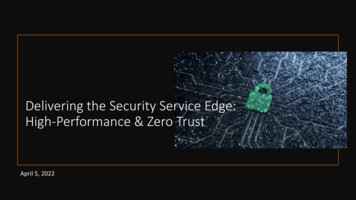

![05[2] Strategy competitors, competitive rivalry .](/img/2/052-strategy-competitors-competitive-rivalry-competitive-behavior-and-competitive-dynamics.jpg)


